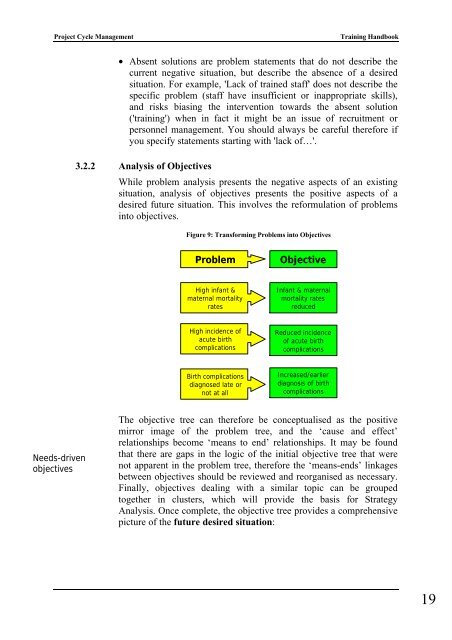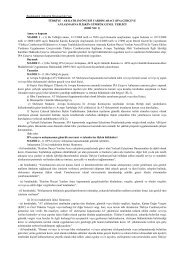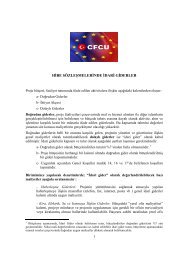Project Cycle Management Training Handbook - CFCU
Project Cycle Management Training Handbook - CFCU
Project Cycle Management Training Handbook - CFCU
You also want an ePaper? Increase the reach of your titles
YUMPU automatically turns print PDFs into web optimized ePapers that Google loves.
<strong>Project</strong> <strong>Cycle</strong> <strong>Management</strong> <strong>Training</strong> <strong>Handbook</strong><br />
Needs-driven<br />
objectives<br />
• Absent solutions are problem statements that do not describe the<br />
current negative situation, but describe the absence of a desired<br />
situation. For example, 'Lack of trained staff' does not describe the<br />
specific problem (staff have insufficient or inappropriate skills),<br />
and risks biasing the intervention towards the absent solution<br />
('training') when in fact it might be an issue of recruitment or<br />
personnel management. You should always be careful therefore if<br />
you specify statements starting with 'lack of…'.<br />
3.2.2 Analysis of Objectives<br />
While problem analysis presents the negative aspects of an existing<br />
situation, analysis of objectives presents the positive aspects of a<br />
desired future situation. This involves the reformulation of problems<br />
into objectives.<br />
Figure 9: Transforming Problems into Objectives<br />
Problem Objective<br />
High infant &<br />
maternal mortality<br />
rates<br />
High incidence of<br />
acute birth<br />
complications<br />
Birth complications<br />
diagnosed late or<br />
not at all<br />
Infant & maternal<br />
mortality rates<br />
reduced<br />
Reduced incidence<br />
of acute birth<br />
complications<br />
Increased/earlier<br />
diagnosis of birth<br />
complications<br />
The objective tree can therefore be conceptualised as the positive<br />
mirror image of the problem tree, and the ‘cause and effect’<br />
relationships become ‘means to end’ relationships. It may be found<br />
that there are gaps in the logic of the initial objective tree that were<br />
not apparent in the problem tree, therefore the ‘means-ends’ linkages<br />
between objectives should be reviewed and reorganised as necessary.<br />
Finally, objectives dealing with a similar topic can be grouped<br />
together in clusters, which will provide the basis for Strategy<br />
Analysis. Once complete, the objective tree provides a comprehensive<br />
picture of the future desired situation:<br />
19





